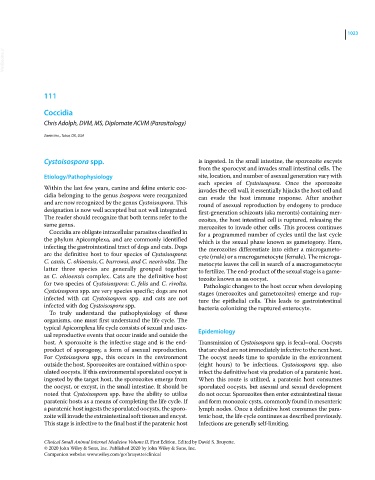Page 1085 - Clinical Small Animal Internal Medicine
P. 1085
1023
VetBooks.ir
111
Coccidia
Chris Adolph, DVM, MS, Diplomate ACVM (Parasitology)
Zoetis Inc., Tulsa, OK, USA
Cystoisospora spp. is ingested. In the small intestine, the sporozoite excysts
from the sporocyst and invades small intestinal cells. The
Etiology/Pathophysiology site, location, and number of asexual generation vary with
each species of Cystoisospora. Once the sporozoite
Within the last few years, canine and feline enteric coc- invades the cell wall, it essentially hijacks the host cell and
cidia belonging to the genus Isospora were reorganized can evade the host immune response. After another
and are now recognized by the genus Cystoisospora. This round of asexual reproduction by endogeny to produce
designation is now well accepted but not well integrated. first‐generation schizonts (aka meronts) containing mer-
The reader should recognize that both terms refer to the ozoites, the host intestinal cell is ruptured, releasing the
same genus. merozoites to invade other cells. This process continues
Coccidia are obligate intracellular parasites classified in for a programmed number of cycles until the last cycle
the phylum Apicomplexa, and are commonly identified which is the sexual phase known as gametogony. Here,
infecting the gastrointestinal tract of dogs and cats. Dogs the merozoites differentiate into either a microgameto-
are the definitive host to four species of Cystoisospora: cyte (male) or a macrogametocyte (female). The microga-
C. canis, C. ohioensis, C. burrowsi, and C. neorivolta. The metocyte leaves the cell in search of a macrogametocyte
latter three species are generally grouped together to fertilize. The end‐product of the sexual stage is a game-
as C. ohioensis complex. Cats are the definitive host tozoite known as an oocyst.
for two species of Cystoisospora: C. felis and C. rivolta. Pathologic changes to the host occur when developing
Cystoisospora spp. are very species specific; dogs are not stages (merozoites and gametozoites) emerge and rup-
infected with cat Cystoisospora spp. and cats are not ture the epithelial cells. This leads to gastrointestinal
infected with dog Cystoisospora spp. bacteria colonizing the ruptured enterocyte.
To truly understand the pathophysiology of these
organisms, one must first understand the life cycle. The
typical Apicomplexa life cycle consists of sexual and asex- Epidemiology
ual reproductive events that occur inside and outside the
host. A sporozoite is the infective stage and is the end‐ Transmission of Cystoisospora spp. is fecal–oral. Oocysts
product of sporogony, a form of asexual reproduction. that are shed are not immediately infective to the next host.
For Cystoisospora spp., this occurs in the environment The oocyst needs time to sporulate in the environment
outside the host. Sporozoites are contained within a spor- (eight hours) to be infectious. Cystoisospora spp. also
ulated oocysts. If this environmental sporulated oocyst is infect the definitive host via predation of a paratenic host.
ingested by the target host, the sporozoites emerge from When this route is utilized, a paratenic host consumes
the oocyst, or excyst, in the small intestine. It should be sporulated oocysts, but asexual and sexual development
noted that Cystoisospora spp. have the ability to utilize do not occur. Sporozoites then enter extraintestinal tissue
paratenic hosts as a means of completing the life cycle. If and form monozoic cysts, commonly found in mesenteric
a paratenic host ingests the sporulated oocysts, the sporo- lymph nodes. Once a definitive host consumes the para-
zoite will invade the extraintestinal soft tissues and encyst. tenic host, the life cycle continues as described previously.
This stage is infective to the final host if the paratenic host Infections are generally self‐limiting.
Clinical Small Animal Internal Medicine Volume II, First Edition. Edited by David S. Bruyette.
© 2020 John Wiley & Sons, Inc. Published 2020 by John Wiley & Sons, Inc.
Companion website: www.wiley.com/go/bruyette/clinical

